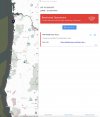Hmm. I'm no stranger to the charts -- lifetime pilot, aircraft owner for decades. I fly around the NW coasts a lot (in my Cessna); hope to do so with my drone, too.
I have always assumed that FAA charts are an authoritative source for airspace restrictions for crewed aircraft, not necessarily for drones. Though I would hasten to add as both a private pilot and a part 107 drone pilot, that I'd assume any restrictions that apply to crewed aircraft also apply to drones. But
I'm not sure that the reverse is always true:
are there not airspace restrictions in place for drones that do not apply to crewed aircraft? Sure there are: National Parks, for example. I can fly over national parks in my Cessna (I do so often) but I can't fly my
Mini 3 Pro over the same national park.
Are we just talking about the perennial issue of takeoff/landing (on a piece of ground) versus overflight?
BTW, I'm quite familiar with the National Marine Sanctuary along Washington's Olympic Coast - you can fly over it (in a crewed aircraft) but flying
below 2000' AGL "violates
NOAA regulations." Note that language (which is printed on the charts). I believe it was chosen carefully...flying below 2000' there does NOT violate
FAA regulations (if it did, they would just say so). I know of some airplane owners who scoff at that 2000' minimum altitude restriction, claiming that NOAA has no jurisdiction over their crewed aircraft flight operations, and that's the reason why the exact language you see on the sectional charts was chosen (because the FAA did not want any part of sorting out complaints that some guy flew his plane over an offshore rock at 1500 feet and disturbed some birds). Note: I do not know if that's true (though it seems very plausible to me, having observed the ways of the FAA for the past 50 years); so I don't claim to know if NOAA has jurisdiction to fine or arrest me if they caught me flying over the Olympic NMS at less than 2000' in my Cessna (I'm pretty sure the FAA really does not care and has no desire to be party to any disputes over that). But I have no interest in being that test case. Before the Olympic NMS went into effect, I had flown over those areas at 1000', occasionally dropped down a bit lower to watch whales and other wildlife; the views were lovely, and I was 100% confident that no wildlife could hear me (little Cessna with a small engine really does not make much noise, even at low altitudes). But once that NMS "notice" started appearing on the maps, I have always kept to over 2000' when flying over those areas and will continue to do so.
I digress, but my point is: I believe the charts are primarily designed for crewed aircraft, and should not be considered to be an
all-inclusive, comprehensive source for ALL restrictions on
drone operations. That is, the charts are a very good starting point (and anything marked as restricted or prohibited should of course be respected), but they may not depict ALL locations where drones are restricted/prohibited.
OK, so back to Oregon...can you point me to the specific source of the FWS regs you would reference? I'm just looking for something a bit more definitive (no offense, disrespect or shade intended).
I note (with a quiet chuckle) that on the Aloft/B4UFLY page, where it says the entire Oregon Coast is a "FWS Wilderness Area" - "Drones are prohibited in all wilderness areas." Labeled
as "Rule URL" it provides a link, but that link is NOT to a FWS or other government agency website. It's to something called
"Wilderness Connect" which appears to be more of an advocacy organization (located on the University of Montana campus). Hmmmm. They may be great folks doing necessary work, but it does not appear (to me) at first glance that they have any authority to prohibit drone flight here ("here" = everywhere along the Oregon Coast).
Interesting issue. Thanks for all insights.













